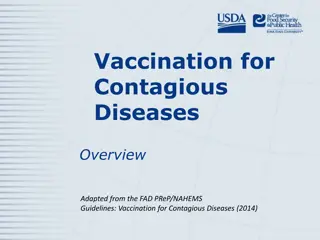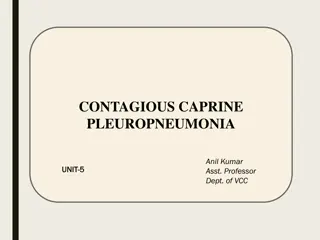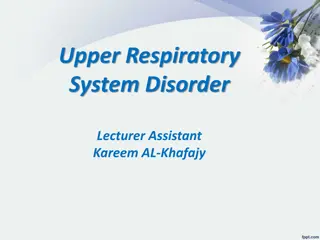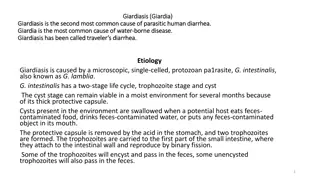Feline Calicivirus
Feline Calicivirus (FCV) is a highly contagious virus that causes respiratory infection and oral disease in cats. It spreads easily in multi-cat environments like shelters and breeding colonies. Learn more about its causes, transmission, and prevention.
0 views • 25 slides
Protect Against Pertussis
Pertussis (whooping cough) and its symptoms, as well as the importance of vaccination. Protect yourself and your loved ones from this contagious disease.
0 views • 10 slides
Understanding Viral Diseases in Poultry: Newcastle Disease and Avian Influenza
Viral diseases like Newcastle Disease (ND) and Avian Influenza (AI) pose significant threats to poultry farming, impacting bird health and production. ND, caused by Avian paramyxovirus type 1, is highly contagious and manifests in various forms affecting birds' respiratory and nervous systems. On th
7 views • 24 slides
Giggle Guide Top 5 Strains That Will Make You Laugh
Laughter is contagious, and when it comes to cannabis, certain strains have a knack for inducing giggles and guffaws. Whether you\u2019re unwinding with friends or simply looking for a mood boost, the right strain can elevate your spirits and leave you in stitches. In this Giggle Guide, we\u2019ll e
2 views • 1 slides
Veterinary Vaccination Guidelines and Regulation Overview
This presentation provides an overview of veterinary vaccination guidelines and regulations, covering topics such as the National Veterinary Stockpile, types of vaccines, vaccine delivery, storage, and handling. It also discusses the regulatory framework governing veterinary vaccines and the role of
5 views • 30 slides
Understanding Diabetes: Causes, Symptoms, and Prevention
Diabetes is a non-contagious chronic illness that affects how the body processes food into energy through the stages and types. It is characterized by increased blood sugar levels and insulin resistance. Common symptoms include increased thirst, hunger, blurry vision, fatigue, and weight loss. While
1 views • 7 slides
Understanding Influenza: Key Concepts and Impact on Public Health
Influenza is a contagious respiratory illness caused by influenza viruses, with symptoms spread through droplets in the air or on surfaces. Vaccination and surveillance play vital roles in controlling flu outbreaks. Understanding the structure and types of influenza viruses, along with the importanc
0 views • 16 slides
Understanding Contagious Caprine Pleuropneumonia in Goats
Contagious Caprine Pleuropneumonia is a severe and frequently fatal respiratory disease affecting goats in India. Caused by Mycoplasma capricolum subsp. Capripneumoniae, it is not transmissible to cattle or sheep. The disease spreads through close contact and inhalation of respiratory droplets, with
0 views • 6 slides
Understanding Enteric Fever (Typhoid Fever): Causes, Contagiousness, and Prognosis
Enteric fever, commonly known as typhoid fever, is an acute illness caused by Salmonella typhi bacteria transmitted through contaminated food or water. This fever is highly contagious, with individuals becoming carriers even after recovering. Close contact, contaminated water, and poor sanitation co
0 views • 18 slides
Foot and Mouth Disease: Overview, Symptoms, and Sequelae
Foot and Mouth Disease, also known as Aphthous fever, is a highly contagious viral infection affecting cloven-hoofed animals. It is characterized by the formation of vesicles and erosions in the mouth, nose, teats, and feet. The disease can cause a fall in milk yield, high fever, loss of appetite, a
1 views • 8 slides
Understanding Glanders: A Contagious Bacterial Disease in Animals
Glanders is a contagious bacterial disease primarily affecting equidae but can also infect other animals, including humans. Caused by Burkholderia mallei, it has a historical occurrence and poses risks globally due to its transmission potential. The etiology, survival characteristics, host range, an
0 views • 19 slides
Understanding Glanders: Causes, Symptoms, and Transmission
Glanders, also known as Farcy, Equinia, or Malleus, is a contagious disease affecting horses, mules, and donkeys. It is caused by the bacteria Pseudomonas mallei and can be transmitted through direct contact or inhalation. The disease manifests with nodules or ulcers in the respiratory tract and on
0 views • 11 slides
Understanding Canine Viral Infection: A Comprehensive Overview
Canine Viral Infection, caused by canine parvovirus-2, is a highly contagious disease affecting dogs, especially puppies. The infection spreads through fecal-oral route and can lead to severe clinical signs like vomiting, diarrhea, and dehydration. The virus replicates in lymphoid tissues, affecting
0 views • 11 slides
What is Influenza (Flu) in Children
Influenza, or the flu, is a contagious respiratory illness caused by influenza viruses. In children, it can lead to symptoms like fever, cough, sore throat, runny nose, and body aches. The flu can sometimes cause more severe complications, so it\u201
2 views • 8 slides
Equine Coital Exanthema: Overview, Symptoms, and Management
Equine coital exanthema, caused by Equine Herpesvirus 3, is a contagious venereal disease affecting horses globally. It primarily manifests as genital lesions in stallions and mares, transmitted sexually or through contact with contaminated materials. While it is typically self-limiting, it can be p
0 views • 23 slides
what is Geographic Tongue and how does it look
Geographical tongue is an non-contagious condition that provides an atypical, map-like structure to the tongue. A detailed note on this problem is given here. For More Info Visit: \/\/ \/what-is-geographic-tongue\/
0 views • 11 slides
what is Geographic Tongue and how does it look
Geographical tongue is an non-contagious condition that provides an atypical, map-like structure to the tongue. A detailed note on this problem is given here. For More Info Visit: \/\/ \/what-is-geographic-tongue\/
0 views • 11 slides
Understanding Strangles in Horses: Causes, Symptoms, and Treatment
Strangles is a contagious upper respiratory tract infection in horses caused by Streptococcus equi var equi. It is characterized by inflammation, swelling, and lymph node abscesses. Transmission occurs through direct or indirect contact, leading to symptoms like depression, fever, nasal discharge, a
0 views • 11 slides
Understanding the Role of Media Narratives in Shaping Market Perception
This paper delves into the impact of financial media narratives post-market crashes and their influence on collective memory, investor behavior, and market volatility. It highlights the association between crash narratives, market indicators, and investor responses, emphasizing the contagious nature
0 views • 22 slides
Understanding Asthma: Symptoms, Causes, and Management
Asthma is a lung disease characterized by inflammation and bronchoconstriction, leading to symptoms like wheezing, coughing, shortness of breath, and chest tightness. It is not contagious and can develop at any age, with early signs like eczema potentially leading to asthma later. Recognizing sympto
0 views • 8 slides
Understanding Fowl Pox in Avian Species: Causes, Symptoms, and Diagnosis
Fowl Pox, caused by Avipoxvirus, is a contagious disease in birds characterized by wart-like nodules and diphtheritic membranes in the throat and mouth. It has multiple forms, including dry pox, wet pox, and coryza-like form, with varying clinical signs. The disease spreads through mosquitoes, bitin
1 views • 10 slides
Kennel Cough: Contagious Canine Respiratory Disease Overview
Kennel Cough, known as Canine Infectious Tracheobronchitis, is a highly contagious respiratory disease affecting dogs, characterized by acute tracheobronchitis and a paroxysmal cough lasting several days. It is caused by various infectious agents, including Canine Parainfluenza Virus and Bordetella
0 views • 12 slides
Overview of Mycoplasma Species and Contagious Bovine Pleuropneumonia
The Mycoplasma genus, including Acholeplasma and Ureaplasma, consists of Gram-negative bacteria with unique characteristics such as lacking cell walls. Mycoplasma species are responsible for causing various diseases in livestock, including bovine and caprine pleuropneumonia. Contagious Bovine Pleuro
0 views • 13 slides
Common Infective Diseases in Cattle and Their Implications
Infective diseases such as blackquarter, brucellosis, and foot and mouth disease pose significant threats to cattle health and food safety. Blackquarter is a fatal disease caused by Clostridium chauvaei, while brucellosis leads to contagious abortion in cattle. Foot and mouth disease is highly conta
0 views • 17 slides
Infection Control and Hand Hygiene Guidelines in Healthcare Settings
Learn about Standard Precautions focusing on hand hygiene to prevent the spread of communicable diseases like Norovirus, MRSA, Influenza, E. coli, and C. difficile. Understand the importance of proper hand hygiene practices in healthcare facilities, such as washing hands with soap and water, using h
0 views • 8 slides
Preventing Influenza in Long-Term Care Facilities: Importance of Vaccination and Hygiene Practices
Influenza, commonly known as the flu, is a contagious respiratory illness that can have severe consequences, especially for vulnerable populations like those in long-term care facilities. This post emphasizes the importance of flu vaccination for residents, staff, and visitors, along with good hygie
0 views • 12 slides
Pediatric Respiratory Conditions Management Overview
Tuberculosis is a contagious respiratory disease affecting children, with drug therapy involving a 6-month course and nursing management focusing on supportive care and treatment adherence. Prevention strategies include isolation, nutrition, and vaccination. Epistaxis, or nosebleeds, are common in c
0 views • 26 slides
Understanding Upper Respiratory System Disorders in Children
Anatomy of the child's respiratory tract, common cold (acute nasopharyngitis), clinical manifestations, treatment and nursing care are discussed in detail, emphasizing the importance of differentiating between various childhood contagious diseases and allergic rhinitis. The content highlights the sy
0 views • 26 slides
Understanding Ringworm: Symptoms, Treatment, and Prevention
Ringworm, a common fungal infection, manifests as small, reddish, itchy patches that form ring-shaped lesions on the skin. It is contagious and can recur over many years if left untreated. Effective treatment involves anti-fungal topical creams or oral prescriptions in severe cases. Exclusion from s
0 views • 42 slides
Mastering Social Media Content Creation Techniques
Breaking through the noise in today's saturated social media landscape requires creating sticky, viral, and contagious content. Learn how to craft meaningful social content, leverage compelling headlines, and tailor your message for different platforms like Facebook and Twitter. Discover the key ele
0 views • 11 slides
Understanding Foot and Mouth Disease in Animals: Causes, Symptoms, and Management
Foot and Mouth Disease is an acute, highly contagious illness affecting cloven-hoofed animals, causing vesicles and erosions in the mouth, nose, teats, and feet. The disease is caused by a positive sense, ss-RNA virus with various serotypes. Transmission occurs through inhalation, direct or indirect
0 views • 8 slides
Understanding Foot-and-Mouth Disease (FMD) and Bovine Viral Diarrhea (BVD)
Foot-and-mouth disease (FMD) is a highly contagious animal disease affecting cloven-hoofed animals, while Bovine Viral Diarrhea (BVD) is a serious cattle disease caused by the BVD virus. FMD is not transmissible to humans and is caused by different strains of Aphthovirus. Symptoms of FMD include ves
0 views • 12 slides
Understanding Avian Influenza: Symptoms, Transmission, and Prevention
Avian influenza, commonly known as bird flu, is a contagious disease caused by flu viruses that primarily affect birds but can also spread to humans. Learn about the symptoms in humans, how the virus spreads, and preventive measures to stay safe. Stay informed and take necessary precautions to reduc
1 views • 15 slides
Understanding Foot Rot in Sheep: Causes, Transmission, and Clinical Findings
Foot rot is a contagious disease in sheep caused by anaerobic bacteria. It leads to lameness and economic loss. This article discusses the etiology, classifications, epidemiology, transmission, pathogenesis, and clinical findings of foot rot in sheep.
0 views • 13 slides
Comprehensive Overview of Infectious Foot Rot (IFR) in Ruminants
Infectious Foot Rot (IFR) is a contagious disease affecting ruminants worldwide, characterized by severe interdigital dermatitis and lameness. It is caused by Fusobacterium necrophorum and other bacteria, leading to inflammation of the sensitive foot tissues. Various predisposing factors and modes o
0 views • 13 slides
Understanding Foot Rot and Digital Dermatitis in Ruminants
This detailed presentation covers Foot Rot (Bovine Foot Rot) and Digital Dermatitis (DD) in ruminants, discussing the etiology, symptoms, treatment, prevention strategies, and more. Foot Rot is caused by Fusobacterium necrophorum while DD is a contagious disease involving multiple bacteria. Treatmen
0 views • 17 slides
Understanding Equine Influenza: An Overview of Respiratory Tract Infections in Horses
Equine influenza is a contagious upper respiratory infection in horses caused by influenza viruses. This article covers the anatomy of the equine respiratory tract, signs, diagnosis, treatment, prevention, and prognosis of equine influenza. It also discusses the histological structure of the respira
0 views • 18 slides
Analysis of Contagious Sets in Random Graphs
The research delves into the concept of contagious sets in random graphs, focusing on bootstrap percolation, random activation, historical perspectives, recent developments, and NP-hard problems. It explores factors like the size of contagious sets, speed of activation, and open problems in the fiel
0 views • 31 slides
Understanding Measles Virus: A Comprehensive Seminar Presentation
The measles virus, also known as rubeola or morbilli virus, is a highly contagious infection that primarily affects the respiratory system. This presentation delves into the classification, characteristics, and pathogenesis of the virus, shedding light on its structure, transmission, and impact on p
0 views • 24 slides
Understanding Giardiasis: Causes, Symptoms, and Prevention
Giardiasis, caused by the parasite Giardia intestinalis, is a common diarrheal illness in humans and animals. It spreads through fecal-oral transmission and can be highly contagious. Symptoms include diarrhea, nausea, cramps, and fatigue. Young children and those in certain risk groups are more susc
2 views • 9 slides







































